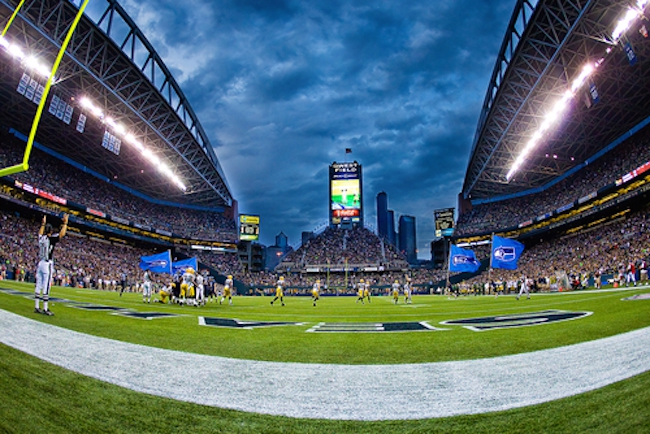
AP Survey: NFL players question teams’ attitudes on health
By Howard Fendrich And Eddie Pells The Associated Press
Features Clinical Patient Care concussion NFL super bowl Stock Photo: Seattle Seahawks play the NFL Champion Green Bay Packers at Century Link Field formerly known as Qwest Field during a Football Game August 21, 2010 in Seattle, Wash. Mat Hayward / Shutterstock.com
Stock Photo: Seattle Seahawks play the NFL Champion Green Bay Packers at Century Link Field formerly known as Qwest Field during a Football Game August 21, 2010 in Seattle, Wash. Mat Hayward / Shutterstock.comDenver Broncos defensive lineman Antonio Smith is a rarity in the NFL: He does not get injured. The Super Bowl will mark his 179th appearance in 180 games since the middle of the 2005 season, a decade of astonishingly good health in a relentlessly violent sport.
Rather than crediting care from his teams, Smith says he managed to suit up week after week thanks in large part to what he arranges on his own.
“You’ve got to get yourself a good system. Chiropractor, massage therapist, stretch therapist. A lot of guys are doing IVs now,” Smith said. “Take care of your body. You’ve got to do that. If the team doesn’t supply it, you spend the money.”
In an Associated Press survey of 100 NFL players released Sunday, plus additional interviews with Smith and others, a picture emerges of a profession where most employees head to work each day all-too-aware of the risks associated with what is commonly described as a 100 per cent injury rate. Many say those lingering concerns affect what happens on the field.
And yet, some insist, they can’t be certain whether they’re receiving the best possible care. Fewer than half of those surveyed, 47 players, said they think the league’s clubs, coaches and team doctors have the athletes’ best interests at heart when it comes to health and safety. Of the rest, 39 said players’ interests don’t always come first, and 14 either weren’t sure or refused to respond.
“Some of the guys I hear stories from, they don’t trust the team opinions,” Jacksonville Jaguars running back Denard Robinson said.
A couple of players mentioned the “conflict of interest” inherent to a team doctor’s job. One labeled players “the asset” that medical staffs need to rush back out there as soon as possible. Another said “everyone knows” the quality of care depends on the size of a player’s pay cheque.
“There’s a lot of pressure on them to keep guys on the field,” Detroit Lions safety Don Carey said.
The AP spoke to 66 players in the NFL at least four seasons, and 34 with less experience. The divide was striking.
Barely a third of the older players, 35 per cent, told the AP they trust that their interests are being protected. That was far lower than the 71 per cent of Years 1-3 players with that outlook.
“Being in the league for a while, that doesn’t surprise me. You hear stories – extreme one way, extreme the other way,” said Smith, in his 12th season.
As co-chairman of the NFL’s player safety advisory panel, Ronnie Lott expressed disappointment when told of such responses.
“We shouldn’t have situations where players are feeling (that way). We should have players sitting there, saying, ‘Yes, they’re trying to give us the best that they can possibly give us,'” Lott said.
Over a two-month span this season, AP reporters posed a set of five questions to at least three members of each of the NFL’s 32 teams to gauge attitudes and anxieties about football.
Among the results from the nonscientific survey:
– 39 of the 100 players said they are more worried about the long-term effects of concussions than other types of injuries.
– 52 rated their general level of concern about injuries as high or medium, while 48 said it was low or nonexistent.
– 70 brought up the notion that injuries are guaranteed to happen to every player and/or mentioned that they know the risks associated with football but aim to set those thoughts aside.
– 71 said they have noticed other players’ play affected by what might be health or injury concerns, and 36 acknowledged their own play has been influenced by such worries.
The NFL told the AP that there were 1,672 injuries during 2015 regular-season games that resulted in missed time, which works out to roughly one for each player in the league. And that doesn’t account for injuries incurred in the preseason, post-season or practices.
“Just like the NFL tells us, there’s a 100 per cent risk of injury,” said New England Patriots cornerback Malcolm Butler, who made the Super Bowl-clinching interception last year. “Everybody’s risk is 100 per cent. So you just stay as safe as you can.”
——
The following AP sports writers contributed to this report: Genaro Armas, Bob Baum, Tim Booth, Dave Campbell, Tom Canavan, Jay Cohen, Schuyler Dixon, Josh Dubow, R.B. Fallstrom, David Ginsburg, Jimmy Golen, Fred Goodall, Will Graves, Joe Kay, Larry Lage, Mark Long, Rob Maaddi, Michael Marot, Brett Martel, Janie McCauley, Paul Newberry, Steve Reed, Kristie Rieken, Dave Skretta, Teresa M. Walker, Dennis Waszak Jr., John Wawrow, Bernie Wilson, Steven Wine and Tom Withers.
Print this page